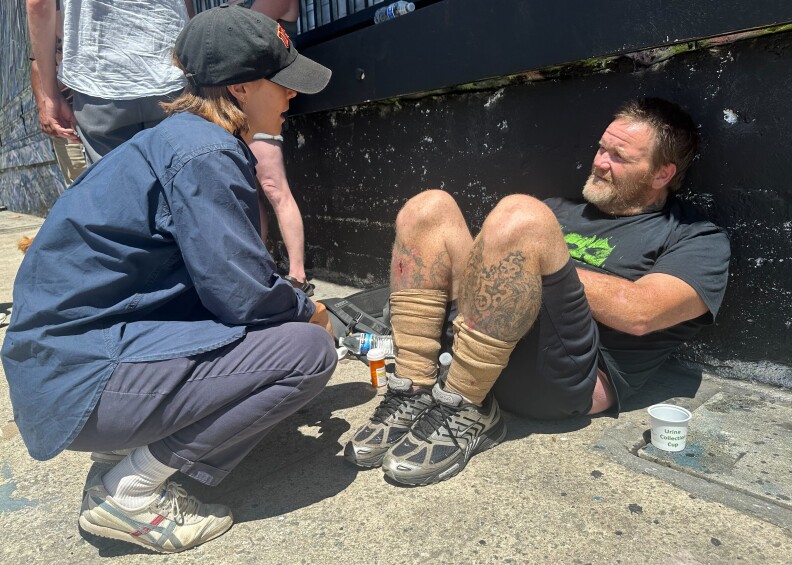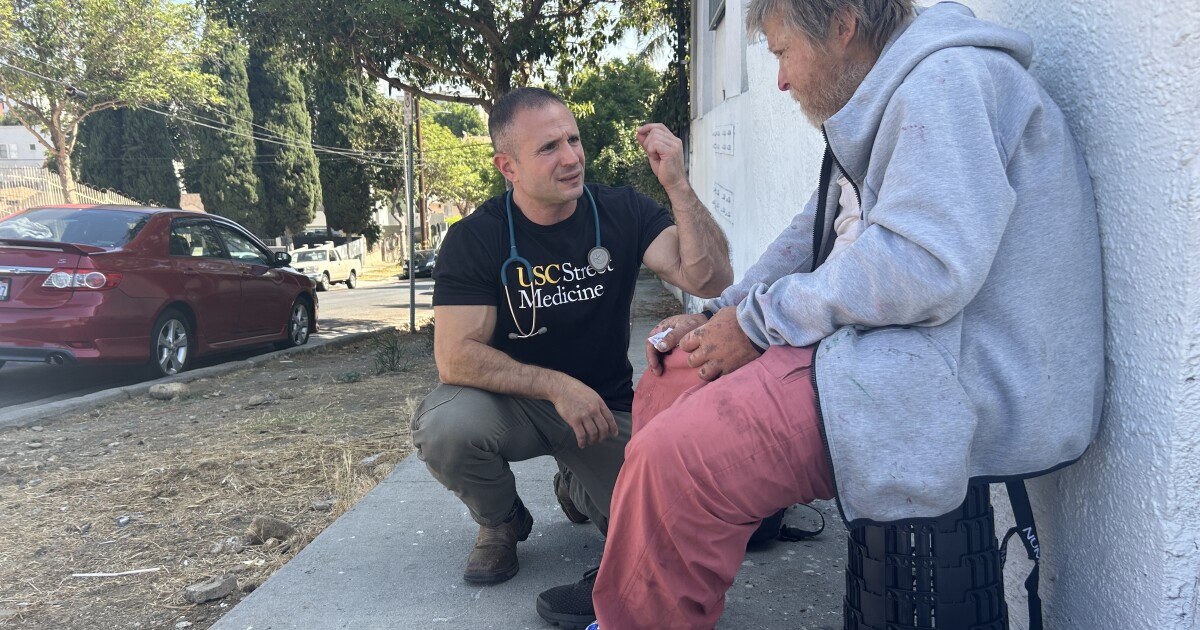Keep up with LAist.
If you’re enjoying this article, you’ll love our daily newsletter, The LA Report. Each weekday, catch up on the 5 most pressing stories to start your morning in 3 minutes or less.
A proposed bill in California’s state Legislature would expand the services street medicine programs can offer unhoused people.
Advocates say the reforms are badly needed — street medics are currently blocked from providing key primary care services such as specialist referrals and access to medical supplies like wheelchairs due to insurance requirements.
Opponents say the expansion would be too expensive — and comes at a time when the state is facing significant budget challenges.
Let’s take a closer look.
What’s the backstory?
Street medicine programs bring health care straight to people living outside on sidewalks, in riverbeds or under bridges all across California. Physicians typically drive dozens of miles a day and carry backpacks to visit unhoused patients directly in tents, makeshift shelters, vehicles or wherever patients happen to be.
Here in L.A. County, more than 47,000 people live outdoors — the region is home to the largest unsheltered population in the country.
That population faces disproportionate rates of chronic disease, mental health disorders and addiction than the overall population. L.A. County’s unhoused residents die at 4.5 times the rate of the overall population, according to the public health department.
When USC Street Medicine director Brett Feldman started practicing street medicine in Southern California a decade ago, there were just six teams across the state, he said.
Feldman said it was a “radical fringe movement” at the time. Since then, teams like Feldman’s have been welcomed into the mainstream health care system, and today there are more than 70 programs across the state. Over a dozen are based in L.A. County.
A big shift came in 2022, when California’s Department of Health Care Services issued guidance to Medi-Cal health plans, enabling street medicine providers to be reimbursed and designated as primary care providers for unhoused patients.
The following year, the federal centers for Medicare and Medicaid created a new billing code for street medicine, making it reimbursable under Medicare and Medicaid nationwide.
As the co-founder and director of the University of Southern California’s influential street medicine program, Feldman currently oversees six teams who treat about 1,200 patients per year.
But, because state rules for Medicaid managed care health plans require patient care be coordinated through a sole primary care provider, programs like Feldman’s often can’t provide a full-range of care to their unhoused patients.

Katia Cnop of USC Street Medicine approaches a tent of a patient in Los Angeles.
How does insurance coverage for people experiencing homelessness currently work in California?
More than 80% of unhoused Californians have health insurance, according to a 2023 UCSF study. The coverage is mostly provided through Medi-Cal, the state’s Medicaid program, which provides free or subsidized health insurance to disabled and low-income people.
Still, studies show unhoused Angelenos disproportionately rely on emergency rooms and ambulance transports for basic medical care.
Most members of local Medi-Cal plans, like L.A. Care or Health Net, are invited to choose a primary care provider through a package in the mail. That doctor is then tasked with coordinating all their care within the network.
For those who can’t get mail, a primary care doctor is assigned automatically. The vast majority of unhoused Californians — more than 90% according to a state legislative analysis — have never visited their primary care doctor or used their insurance benefits. Still, that physician remains the only one who can order them “medically necessary services,” under current Medicaid rules.
Feldman, with USC’s street medicine program, said he encounters patients daily who he’s unable to help. Under the current rules, he can’t order them X-rays, prescribe a wheelchair or make referrals to a specialist.
“When I see them on the street, I’m not their assigned primary care provider, and I can’t order basic things for them,” Feldman said. “Only the person who they’re not seeing can order those things.”
Assembly Bill 543, which Feldman helped craft with the bill’s author Assemblymember Mark González, would change that. Co-authors include Assemblymembers Sade Elhawary, John Harabedian, Celeste Rodriguez, Pilar Schiavo and Matt Haney.
“It makes it so that regardless of [primary care provider] assignment, we can order what they need based on their medical necessity,” Feldman said.
The bill passed unanimously through the state Assembly this summer. It’s now scheduled for a state Senate appropriation committee hearing on Aug. 29.

Assemblymember Mark González, center, at a press conference in Los Angeles with Mayor Karen Bass and a Congressional delegation on June 13, 2025.
(
Courtesy Assemblymember Mark González
)
Why do advocates say reforms are needed?
Medi-Cal managed care health insurance plans, funded by state taxpayers, get paid at a per-patient per-month rate. That money is paid out regardless of whether patients use the coverage.
The system works for most people on Medi-Cal, Feldman said — patients typically stay away from the doctor when they’re feeling well, keeping costs down. But without reliable access to phones or transportation, unhoused patients struggle to make and keep medical appointments.
There’s a huge gap between the insurance benefits unhoused patients are eligible for and the benefits they’re actually able to use, according to a 2023 street medicine landscape report authored by Feldman.
“There are certain groups, insurance groups, who are creating so many different barriers to being preventative,” said González, the state lawmaker who authored the bill. “You cannot do that if your goal here is to heal people.”
Some Medi-Cal health insurance plans acknowledge the challenges, including L.A. Care, the nation’s largest publicly operated health plan with more than 2 million members.
“We recognize it as a problem,” said Charlie Robinson, senior director of the community health department at L.A. Care. “It’s a very normal circumstance for most members — you need to go to your PCP first and then they can refer you. But it doesn’t fit well with this population.”
L.A. Care covers about 70% of unhoused people in L.A. County on Medi-Cal, the agency estimates.
The health plan says it has found another workaround to the problem, launching its own “field medicine” pilot last year. That effort partners with street medicine programs and allows those practitioners to become primary care providers within L.A. Care’s network.
Still, the agency is “conceptually aligned” with AB 543, Robinson told LAist.

Yelipsa Madera (L) Michael Gallagos (M) and Brett Feldman (R) are part of the Keck School of Medicine of USC’s Street Medicine teams.
(
Robert Garrova / LAist
)
How much would the new legislation cost taxpayers?
The California Department of Finance is opposing the street medicine bill, citing cost concerns. The state agency, which advises Gov. Gavin Newsom’s office on fiscal policy, wrote in a recent analysis that AB 543 would cost the state tens of millions of dollars each year in new spending that hasn’t been approved through the state’s budget process.
“Efforts to expand the scope of Medi-CAL should be considered as part of the annual budget process,” the agency wrote, arguing against new legislation.
The bill, if approved, would also require new coordination between providers and street medics and new tracking numbers.
The state’s finance department noted that Newsom vetoed similar street medicine legislation in 2021 after it passed unanimously through the California Legislature.
González argues the proposed legislation is proactive and cheaper than unhoused people visiting emergency rooms.
“This is the first line of defense,” González said. “Street medicine is preventative so that we don’t clog up those resources.”
For now, street medicine providers say they are absorbing a lot of the costs of doing things that insurance plans are already being paid to do, but aren’t.
José Luis Gonzalez, medical director at street medicine provider Healthcare in Action, testified before the state senate in support of the bill in June, recalling a patient who could not access their primary care provider.
“ The taxpayers are paying for this gentleman to have insurance,” Gonzalez said. “He has insurance and he can’t access it. Us providing the service, we’re not even getting paid for this.”
Making his rounds last month, USC’s Feldman spotted his patient Dustin Statler, slouched against a retaining wall in L.A.’s Westlake neighborhood.
Statler, 46, had just been discharged from a hospital emergency room, where he’d received dialysis treatment. He’s been homeless in L.A. for a decade. His kidneys are failing.
Feldman said he was able to provide food and basic medicine, but under current rules, he couldn’t refer Statler to a kidney specialist for routine dialysis appointments. Only Statler’s primary care provider, who Statler had never been to, could make the call, Feldman said. But connecting him with that provider could take months.
“ He needs dialysis three times a week,” Feldman said. “If he waited one to two months for dialysis, he will die.”

Katia Cnop of USC’s street medicine program visits with a patient.
What will the Trump administration’s changes to Medicaid mean for California?
AB 543, the proposed state law, would automatically enroll unhoused people into insurance coverage, creating a bigger safety net for changes coming in 2027, according to advocates of the legislation. That’s when the Trump administration says Medicaid recipients will be required to hold jobs in order to get their benefits.
Advocates and some health plans say Trump’s Medicaid changes will result in the vast majority of unsheltered Angelenos losing their coverage.
Trump’s ‘Big Beautiful Bill,’ which announced the Medicaid work requirements, also lists exemptions for certain groups. Those include people with disabilities, substance use disorders or serious medical conditions.
But providers say those could be hard to prove, as some require official diagnoses and other paperwork. Some of that work will fall on street medicine providers.
If street medics can automatically enroll unhoused people into Medicaid, as AB 543 would allow, they may be able to help prevent coverage gaps by certifying people for automatic enrollment in advance.
“We can treat them now, and then it’ll give us a runway in order to complete all the paperwork to certify that they have a mental illness and would get permanent insurance,” said Feldman with USC.
Dr. Katia Cnop, associate medical director of USC Street Medicine, is an addiction specialist. With the upcoming changes to Medicaid, she sees her role changing into one where she has to defend unhoused people’s insurance rights.
She believes those insurance challenges ultimately will land more unhoused people in emergency rooms, leading to longer wait times for the entire community.
“The ER becomes super congested and you go from having a six hour wait time to a 24 hour wait time, and it becomes an impossible situation for anyone,” she said.
